This healthy burger and fries recipe is easy, and you can customize the hamburger patties in ways you can’t when you order fast food. The baked potato French fries are a snap to make and are both healthier and tastier than take out. The nutrient breakdown of this homemade healthy burger recipe makes it worth a little extra work!
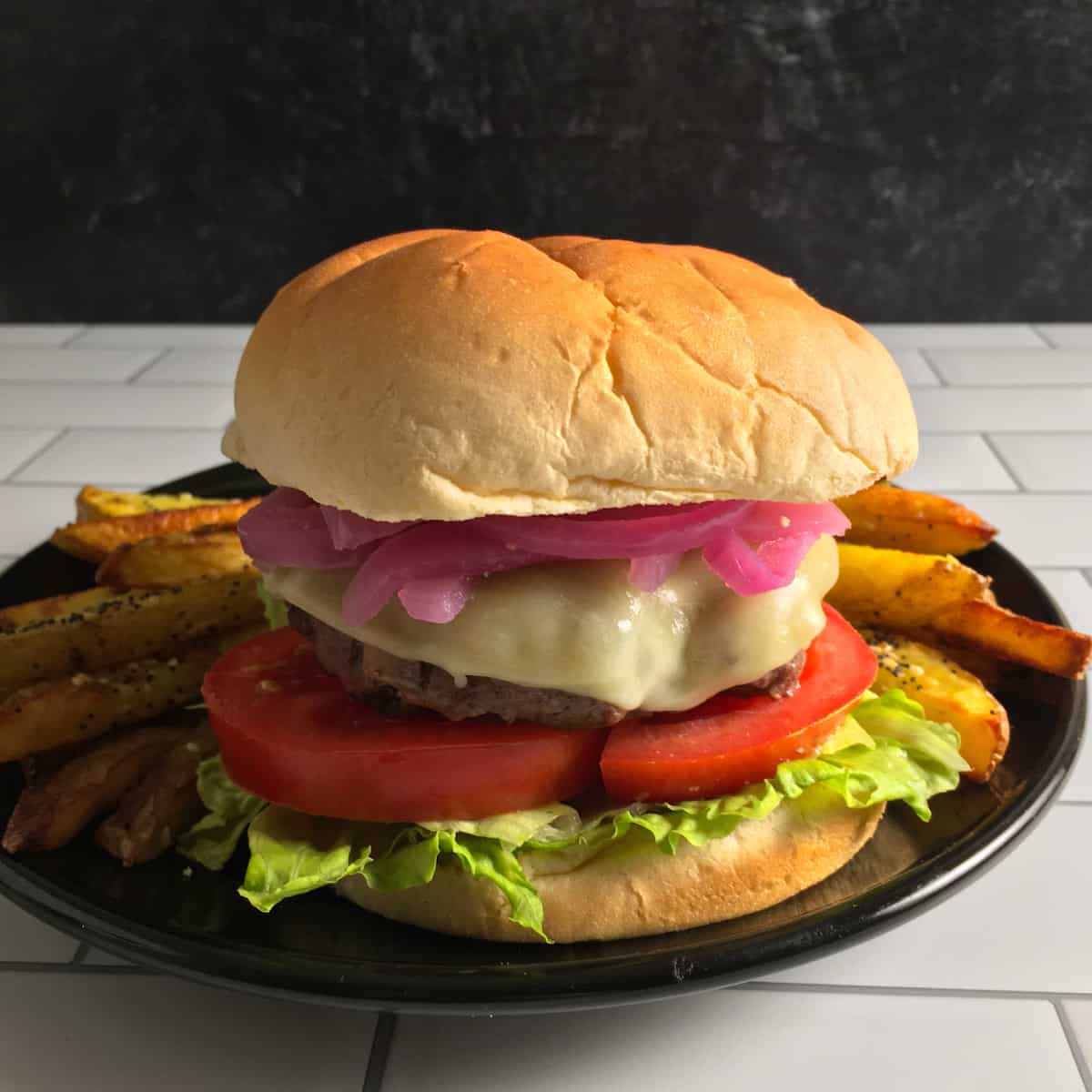
Want to save this post?
Enter your email below and we'll send it straight to your inbox. Plus you'll get great new recipes from us every week!
Learn how to make a healthy burger and fries from a registered dietitian (AKA a healthy burger and chips in the UK and Australia). If you don’t like to cook, it may feel like a waste of time to make a healthy burger. Why not just hit the drive-thru for fast food and save some time and money?
However, making fast food combo meals a part of your regular routine may eventually catch up to you and ultimately cost more. Poor diet quality may not only lead to higher long-term healthcare costs but also missed time at work. Choosing better food options now is an investment that may help you save in the future.
Sometimes you get what you pay for. Though there are no guarantees in terms of health outcomes, making healthier diet and lifestyle choices does help to reduce risks.
But burgers and fries are burgers and fries, whether from home or a fast food place, right? Not necessarily. What follows are some of the reasons that making your fast food is probably a better choice.
Table of Contents
- ❓ Is a burger and fries healthy?
- 🍔 Healthy Burger and Fries Ingredients
- ⭐ Healthy Burgers Ingredients
- ➕ How to Make Healthy Burgers
- 📋 Burger and Fries Calories
- 🤔 What is a good substitute for fries with burgers?
- FAQs
- 👨🏾🍳 Best Healthy Burger Recipes
- 📖 Recipe Card
- 💭 Expert Tips from Dietitian Summer Yule
- 👩🏻🍳 Other Healthy Recipes
- 💬 Comments
❓ Is a burger and fries healthy?
It can be! Here is the nutrient breakdown of the McDonald’s quarter pounder with cheese and medium fries to our burger with fries. The quarter pounder starts with 4 ounces of raw beef per patty, just like our burger (source).
| Calories | Protein (g) | Saturated Fat (g) | Sodium (mg) | Calcium (%DV) | Iron (%DV) | |
|---|---|---|---|---|---|---|
| Our Burger & Fries | 452 | 32.6 | 7.4 | 482 | 15.3 | 18.4 |
| McDonald’s Burger & Fries | 840 | 35 | 14 | 1400 | 17 | 29 |
I’ve included neither the soda (in a typical McDonald’s combo meal) nor the salad (in our meal) in this analysis. Adding these in would give an even more significant advantage to our healthy burger and fries.
The McDonald’s burger and fries are much higher in calories, saturated fat, and sodium than our homemade burger. This difference is true of many restaurant foods compared to home-cooked, though some restaurants do offer healthier options. Eating out tends to be particularly challenging for those on low-sodium diets.
We were able to bring down the calories and saturated fat in our meal by using leaner beef than McDonald’s uses. (They use 80/20, we used 90/10 lean ground beef.) Skipping the condiments and refined grain bun on the burger also helps to lighten the meal.
The McDonald’s burger has an edge on iron, but this is likely the less bioavailable non-heme iron from the fortified bun. Both burgers are packed with heme iron from the beef. Skipping the bun also reduces sodium and calories, so this is a good trade-off, IMHO.
Ordering a combo meal (which adds a soda) would bring the McDonald’s meal to over 1,000 calories. That is over half of the daily energy needs for many adults for a meal that may not be very filling.
🍔 Healthy Burger and Fries Ingredients
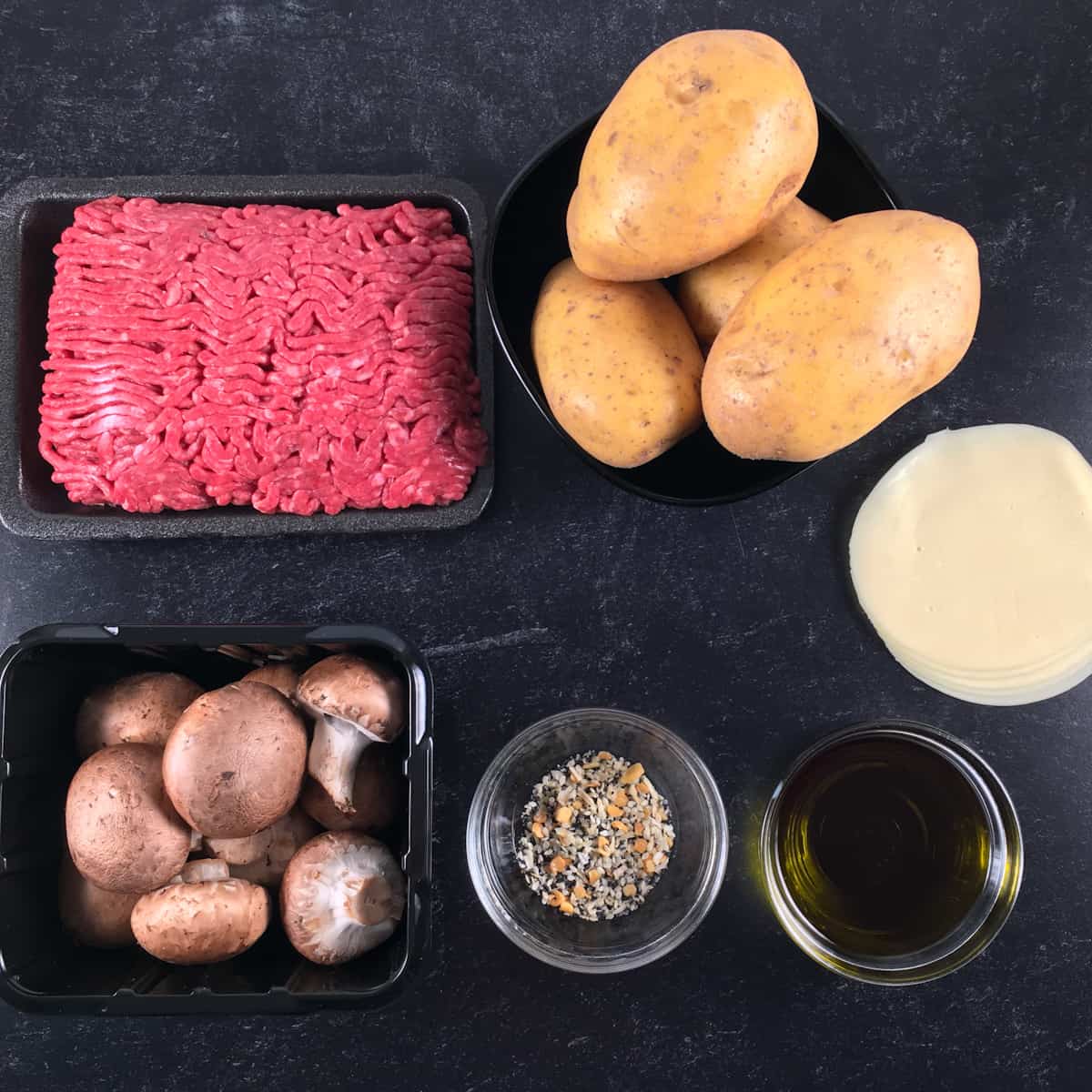
Beyond the nutrient breakdown, the ingredients used at home may be of higher quality. If you are trying to limit your consumption of ultra-processed foods, home-cooked is the way to go.
For example, my oven-baked fries contain the following ingredients: potatoes, oil, Everything But the Bagel seasoning.
On the other hand, here is the ingredient listing for the McDonald’s fries: Potatoes, Vegetable Oil (Canola Oil, Corn Oil, Soybean Oil, Hydrogenated Soybean Oil, Natural Beef Flavor [Wheat and Milk Derivatives]*), Dextrose, Sodium Acid Pyrophosphate (Maintain Color), Salt. *Natural beef flavor contains hydrolyzed wheat and hydrolyzed milk as starting ingredients.
Many assume that fries are diet-compliant for those with a dairy allergy or vegetarians. This may not always be the case.
When you order out, you may be surprised at how they are making the food. It may look nothing like how you'd do it at home, even if the end results appear similar.
One of my first jobs was in a fast-food restaurant. They would reuse the frying oil over and over again until it turned almost black. It was not very appetizing-looking at that point, that is for sure!
⭐ Healthy Burgers Ingredients
Do you need another example? Many of the fast-food restaurants use processed cheese food instead of regular cheese on their burgers. Processed cheese food is also known as “American cheese.”
Here is the ingredients list for the “cheese” used at one popular fast food restaurant: Cheese (milk, modified milk ingredients, bacterial culture, salt, calcium chloride, microbial enzyme, lipase), modified milk ingredients, water, sodium citrate, salt, citric acid, colour, soy lecithin.
Here is the (much simpler) ingredients list for the provolone cheese we used at home: Pasteurized milk, cheese cultures, salt, enzymes.
When you make food at home, you can skip all of the preservatives and ultra-processed ingredients. Two cheese slices that look the same may have very different ingredients lists.
P.S. Want to know how to make the standard American diet (SAD) even worse? Try substituting the processed cheese food and beef burgers for some of the nutrient-poor “plant-based” alternatives. For example, here is the ingredients list for a typical non-dairy “cheese”:
Ingredients: Filtered Water, Potato Starch, Coconut Oil, Canola and/or Safflower Oil, Tricalcium Phosphate, Vegan Natural Flavours, Salt, Pea Protein, Xanthan Gum, Lactic Acid (Vegan), Konjac Flour, Fruit and/or Vegetable Juice (Color), Annatto Color, Yeast Extract, Vegan Enzyme, Vitamin B12.
Though they fortified this product with calcium (of questionable bioavailability) and vitamin B12, it lacks the protein, riboflavin, and other nutrients in cheese. That is why many dietitians advise limiting these products; they are mostly empty calories. In this case, the cheese alternative is made chiefly of starch plus an added oil that is high in saturated fat.
All “junk food” is not created equal. Many people need the nutrients they can squeeze from fast foods since they are not consumed in moderation. Replacing meals with these alternatives that are devoid of nutrients is not a step towards health.
➕ How to Make Healthy Burgers
Time to make a healthy cheeseburger and fries recipe! Get a printable recipe card below, or here are the step-by-step instructions:
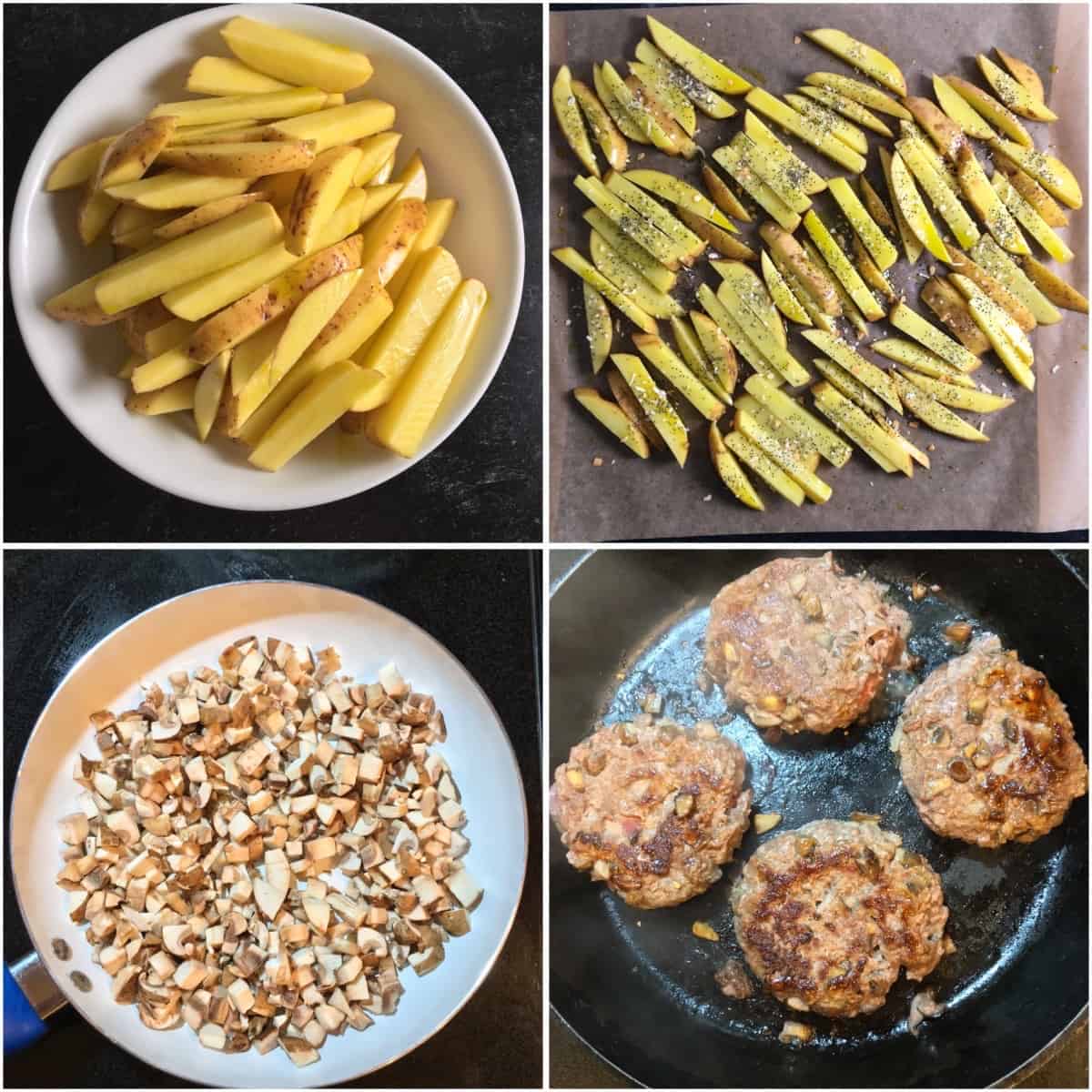
Make Healthy Fries
- Preheat the oven to 400°F (200°C). Place a sheet of parchment paper on a dark baking sheet.
- Wash 3 medium potatoes, pat them dry, and cut them into ½-inch thick (1.27 cm) fry shapes. If you use thin-skinned potatoes there is no need to peel them.
- Place the cut potatoes in a bowl and stir in 2 tablespoons of olive oil.
- Using your hands, spread the fries out in a single layer on the cookie sheet. If you did not cut the potatoes to an even thickness, put thin pieces in the middle of the sheet and thick pieces on the outer edges. This will help them to cook more evenly.
- Sprinkle the fries with the Everything But the Bagel Seasoning. Put the baking sheet on an oven rack ⅓ down from the top of the oven.
- Bake the fries for 20 minutes, flip, and bake an additional 15-20 minutes. (You’re welcome to bake them longer if they still aren’t crispy enough!)
- While the fries cook, prepare the burgers.
Make Healthy Burgers
- Spritz a cast-iron skillet lightly with cooking oil spray.
- Dice 8 ounces of mushrooms (227g) into ¼-inch pieces (0.6 cm). Saute the chopped mushrooms in the skillet for about 10 minutes, letting the liquid cook off. It is difficult to burn mushrooms, so don't worry about cooking them perfectly.
- Place 1 lb raw lean ground beef (454g) in a large bowl. Add the mushrooms, and thoroughly combine them with your hands.
- Divide the burger mixture into four pieces. Roll each piece into a ball and then flatten each into a patty.
- Cook the patties in the heated skillet (the one you used for the mushrooms). They will take about 5-7 minutes per side over medium heat.
- Don't forget to flip your fries if it is time to do so!
- Top each burger with a slice of cheddar cheese or provolone cheese during the last minute of cooking. The cheese should melt over the burger. Quickly get the burgers off the heat and on the plates, so the cheese does not burn.
- Plate the fries and burgers, and add any desired toppings (e.g., lettuce, tomatoes, red onions, pickles, mustard, burger sauce, etc.). I highly recommend adding a salad to help balance out the meal. Enjoy!
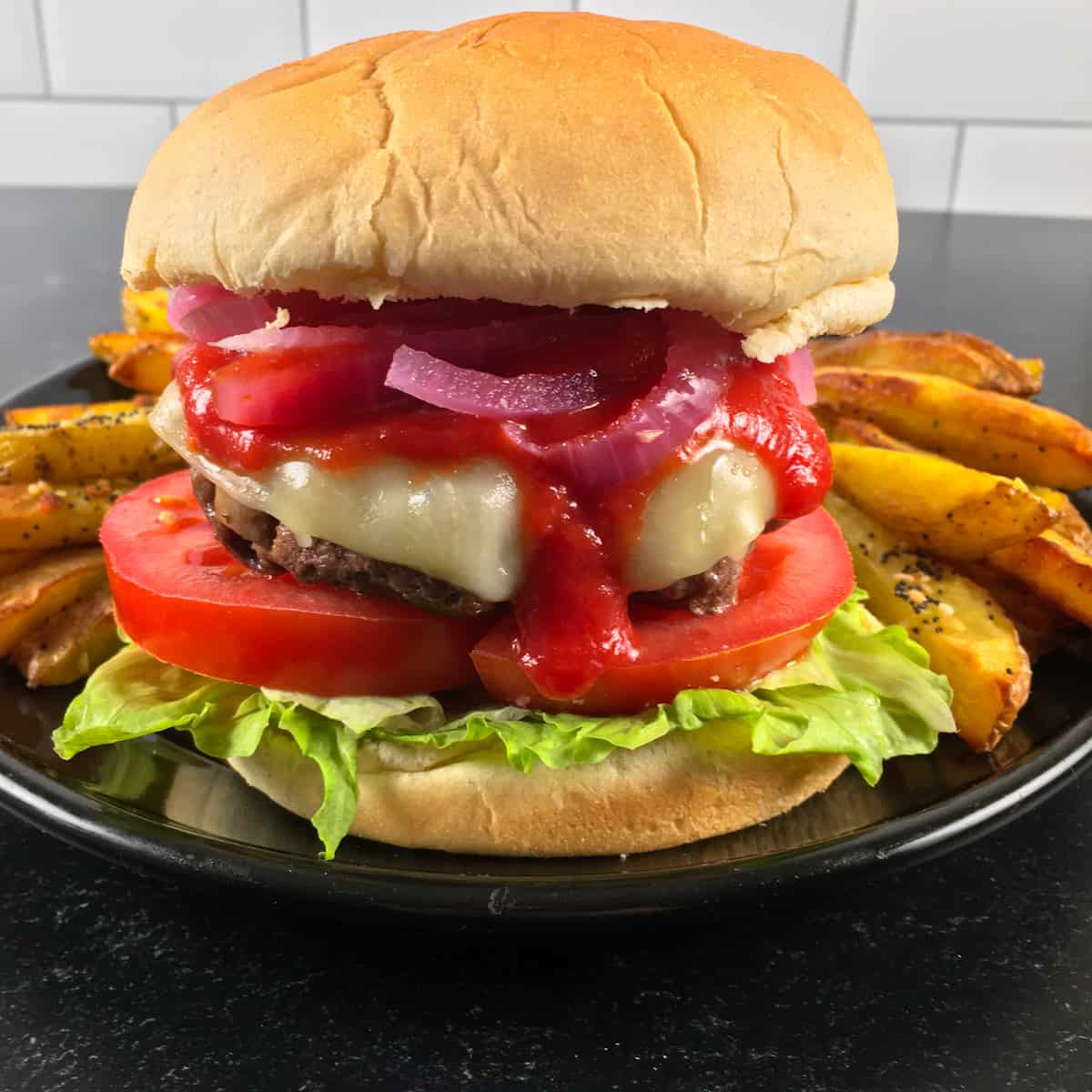
Don’t be afraid to customize this simple recipe to fit your taste preferences! Many add-ins and swaps not only make the food taste better, but they also add more nutrients. It’s truly a double win.
For example, one of my family members loves mushrooms, so we often add sautéed mushrooms to burger and meatloaf recipes. I prefer sweet potatoes over white potatoes, so I will typically choose to make sweet potato fries. (Not this time, since another family member prefers the classic fry made with white potatoes.)
Burgers and Fries Storage
Leftover burgers and fries can be kept in an airtight container in the fridge for up to 3-4 days. Reheat the burgers (with no bun) in the microwave for 1-2 minutes on high.
Here are some specific directions on How to Reheat McDonalds Burger. These instructions on How to Reheat McDonalds Fries works with other thin fries as well.
Plain burgers without buns or toppings can be stored in the freezer. Put them in a vacuum sealed bag or in a freezer bag with the air pressed out. Cooked fries change in texture when frozen and thawed, so freezing is not recommended.
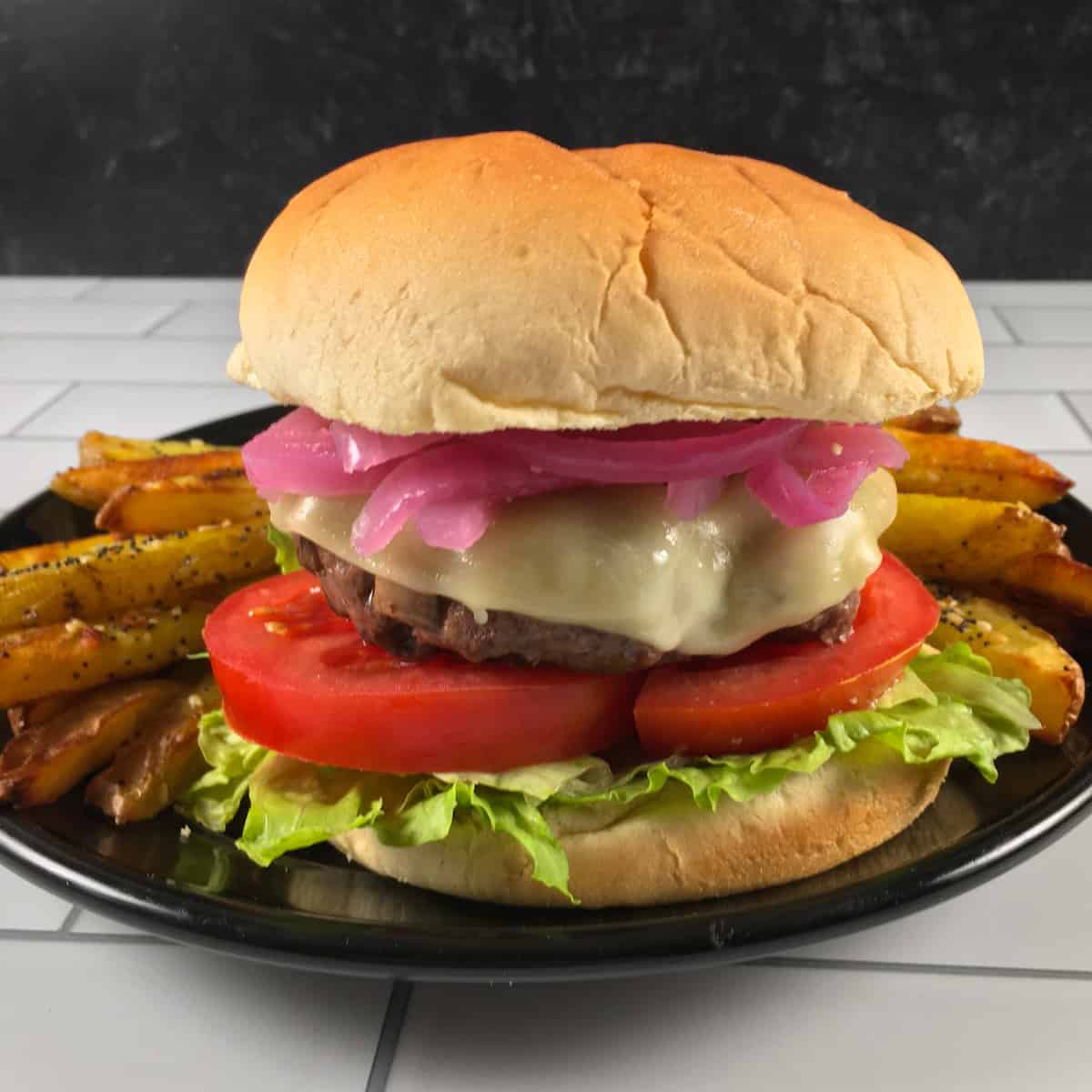
📋 Burger and Fries Calories
How many calories in a burger and fries? This cheeseburger and fries recipe has 452 calories, 25.8 grams net carbs, and 32.6 grams protein. This does not include a bun or any burger toppings and condiments you choose to add.
The calories in cheeseburger and fries ultimately depends on your portion size and how it was made. As shown above, the calories in burger and fries from a fast food restaurant may be much higher than homemade burger calories. (The opposite can also be true, depending on how you make your burger.)
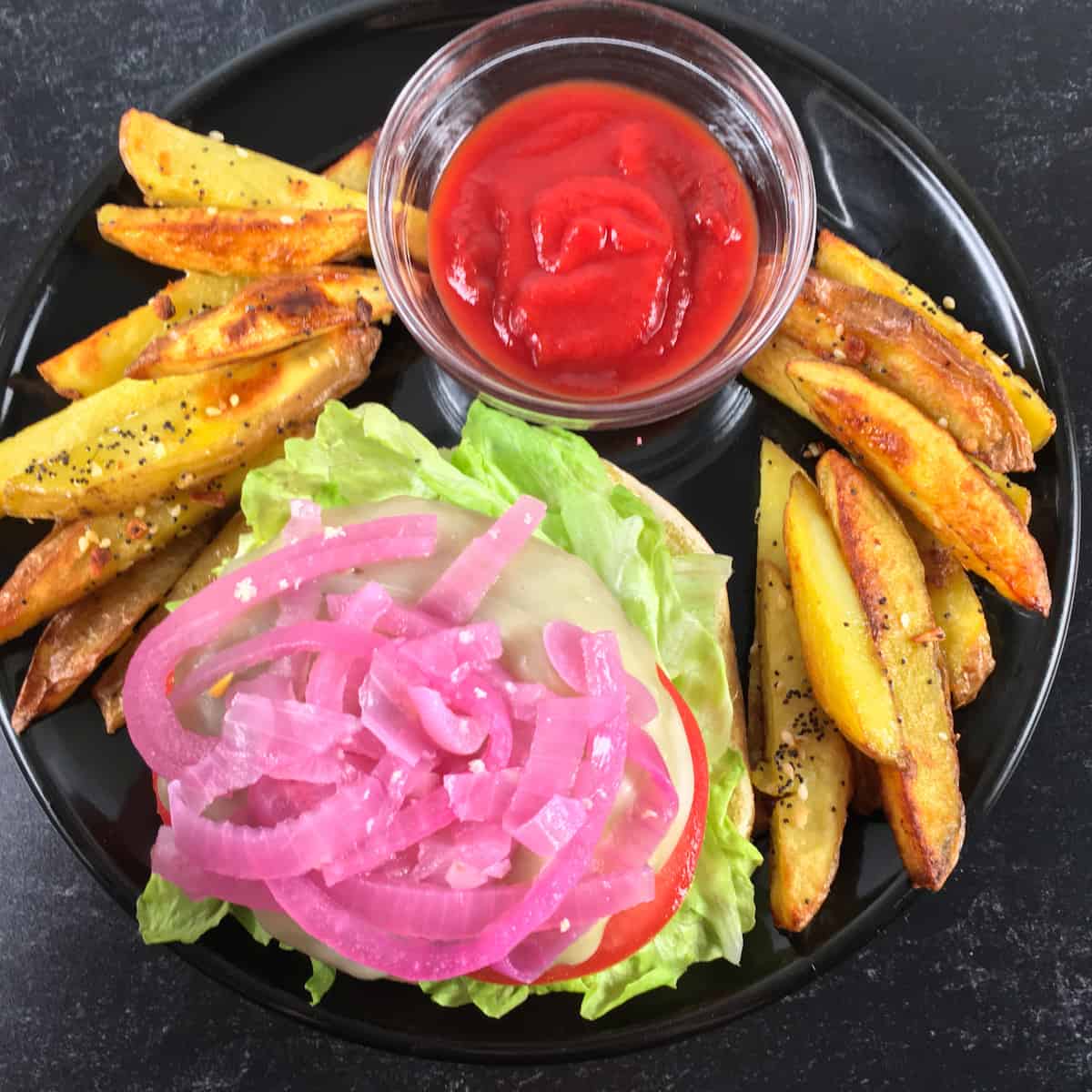
🤔 What is a good substitute for fries with burgers?
What are some good sides for burgers? Here are some of my favorite substitutes for fries with a burger meal that fit a variety of special diets:
FAQs
What's healthier burger or fries?
The healthiest way to eat a burger is always dependent on what your needs are. If you’re looking for high protein, low carb, gluten free, or minimally processed options, the burger is better than the fries. Order at least two burger patties (since they’re only 2 ounces each) and skip the bun.
What’s the healthiest burger at McDonald’s?
In terms of general health, fast food burgers aren’t the best choice. In this case, I’d call the lowest calorie hamburger the “healthiest,” with the hopes you largely get nutrition from other foods. The lowest calorie burger at McDonald’s is the plain hamburger, at 240 calories.
Is it OK to eat a burger and fries every day?
As long as there’s no medical contraindications, it’s possible to fit small amounts of just about any food in an overall healthy diet daily. However, having a certain treat food daily can end up crowding healthier options out of your diet. The typical high calorie burger and fries meal isn’t a good fit for the daily diet of most people.
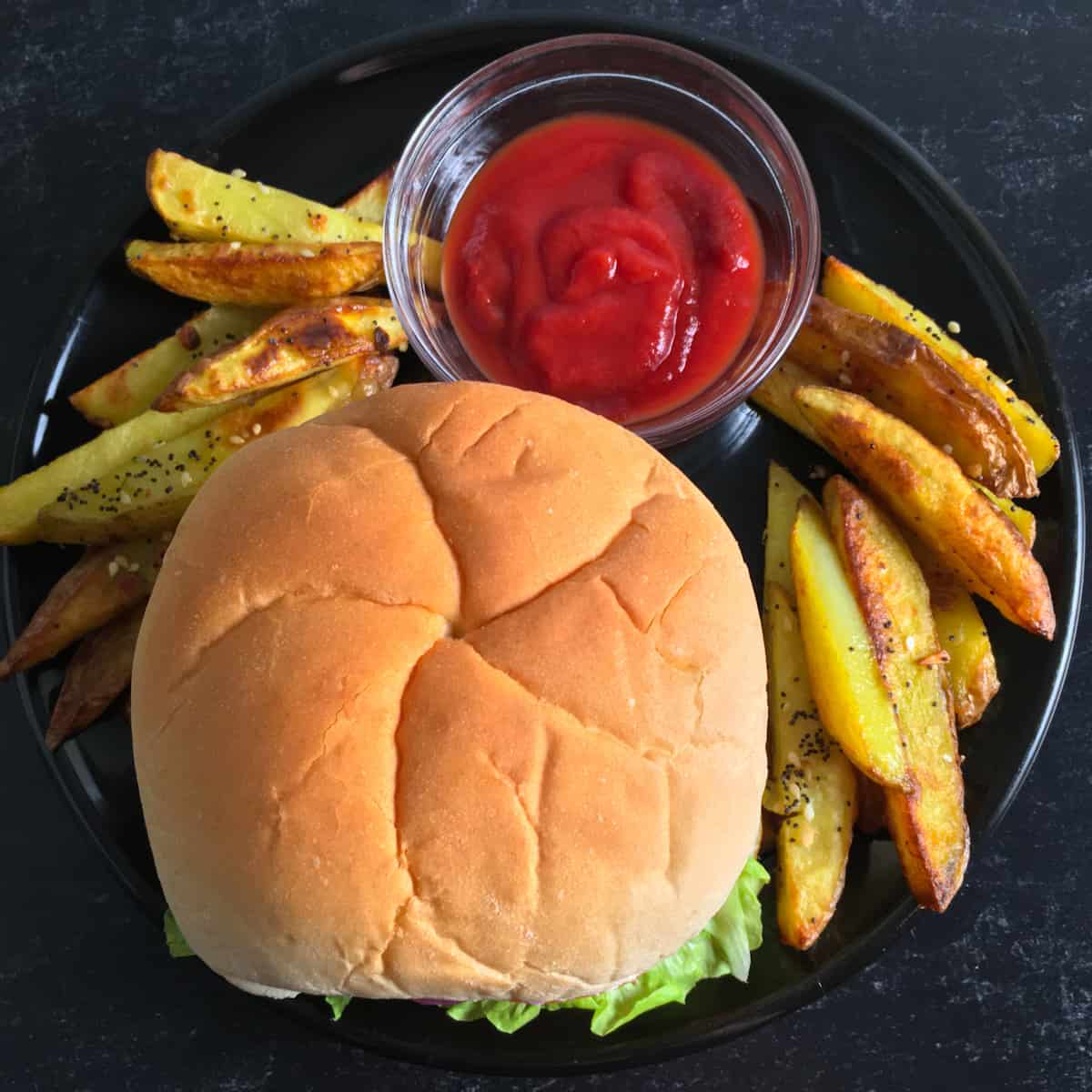
Is steaming a burger healthier than frying it?
Deep frying burgers adds a lot of extra fat and calories to your burger. Steaming burgers is (in general) a better choice than frying. Pan frying, using a grill, or air frying burgers often doesn’t add oil and the results are more nutritionally similar to steaming.
Are thick fries healthier than thin fries?
Thick fries have less surface area and might absorb less oil when fried, at least in theory. If you oven bake fries, thick and thin fries are nutritionally similar if prepared with equal amounts of oil and seasoning.
👨🏾🍳 Best Healthy Burger Recipes
Now you know the answer to “Can I eat a burger and still be healthy?” is yes! Here are some other hamburger recipes you might find helpful if you’re on a weight loss journey. (Skip the bun on these for low carb burgers.)
- Air Fryer Turkey Burgers (No Breadcrumbs) (a secret ingredient makes these ground turkey burgers more moist than a typical lean diet burger!)
- Frozen Burgers in Air Fryer
- Elk Burger
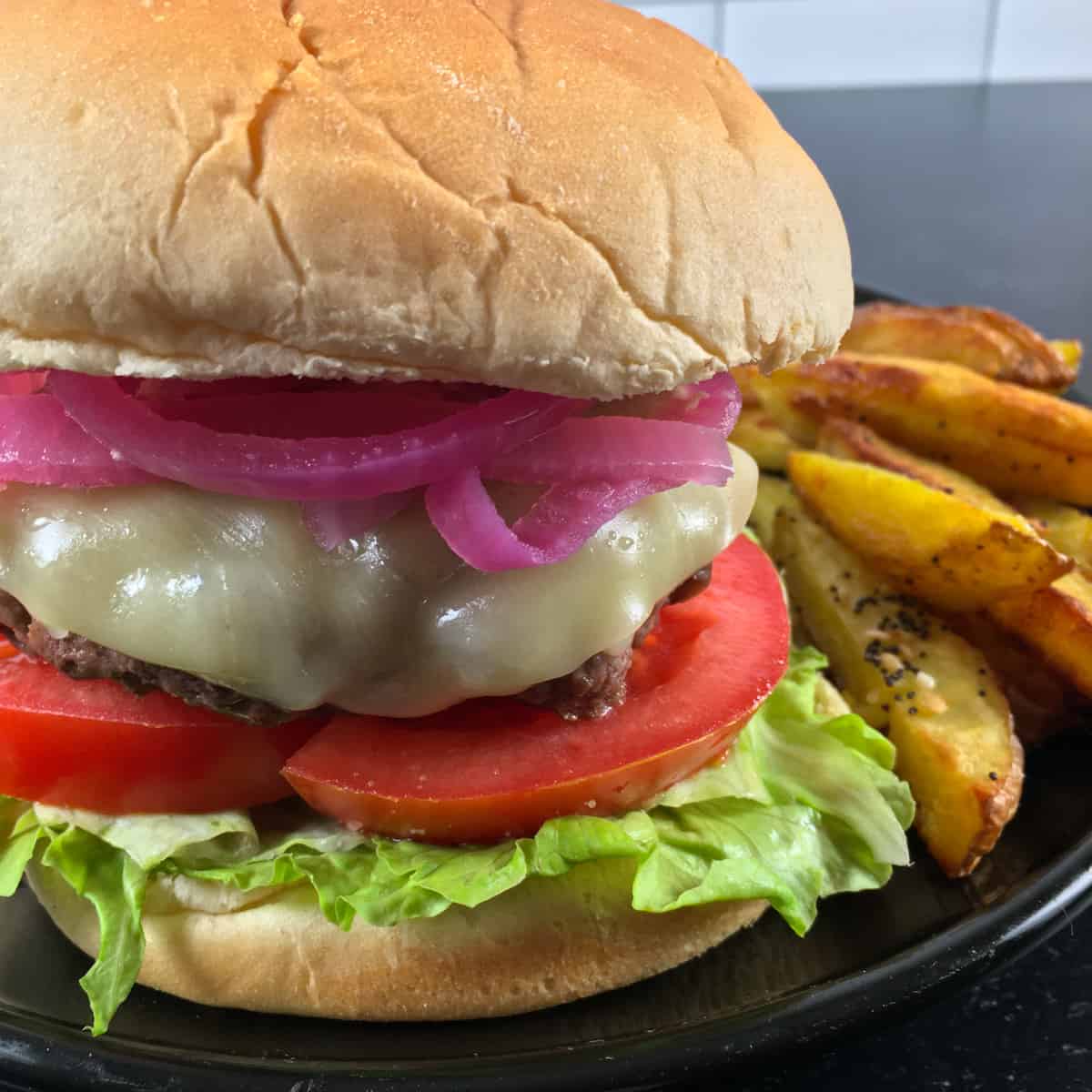
📖 Recipe Card
Watch How to Make It!
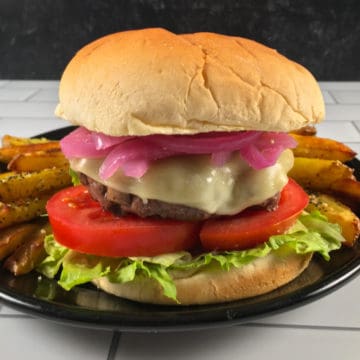
Healthy Burger and Fries Recipe (How to Make Healthy Burgers)
Ingredients
For the healthy fries:
- 3 medium Yukon gold potatoes (total weight: 23 ounces/652 grams)
- 2 tablespoons olive oil
- 2 teaspoons Trader Joe's Everything But the Bagel seasoning (or your choice of spices)
For the healthy burgers:
- 1 lb. ground beef, lean (454 grams; 90/10 ground beef)
- 8 ounces mushrooms, finely chopped (227 grams)
- 4 slices provolone cheese (1-ounce/28 gram slices)
- cooking oil spray of choice
For serving:
- mixed greens and dressing of your choice (1.5 c greens and 1-2 tablespoons dressing per person)
- burger toppings and other veggies for the salad (optional)
Instructions
To make healthy fries:
- Preheat the oven to 400°F (200°C). Place a sheet of parchment paper on a dark baking sheet.
- Wash the potatoes, pat them dry, and cut them into ½-inch thick (1.27 cm) fry shapes. If you use thin-skinned potatoes there is no need to peel them.
- Place the cut potatoes in a bowl and stir in the oil.
- Using your hands, spread the fries out in a single layer on the cookie sheet. If you did not cut the potatoes to an even thickness, put thin pieces in the middle of the sheet and thick pieces on the outer edges. This will help them to cook more evenly.
- Sprinkle the fries with the Everything But the Bagel Seasoning. Put the baking sheet on an oven rack ⅓ down from the top of the oven.
- Bake the fries for 20 minutes, flip, and bake an additional 15-20 minutes. (You’re welcome to bake them longer if they still aren’t crispy enough!) While the fries cook, prepare the burgers.
To make healthy burgers:
- Spritz a cast-iron skillet lightly with cooking oil spray.
- Dice mushrooms into ¼-inch pieces (0.6 cm). Saute the chopped mushrooms in the skillet for about 10 minutes, letting the liquid cook off. It is difficult to burn mushrooms, so don't worry about cooking them perfectly.
- Place the raw burger in a large bowl. Add the mushrooms, and thoroughly combine them with your hands.
- Divide the burger mixture into four pieces. Roll each piece into a ball and then flatten each into a patty.
- Cook the patties in the heated skillet (the one you used for the mushrooms). They will take about 5-7 minutes per side over medium heat.
- Don't forget to flip your fries if it is time to do so!
- Top each burger with a slice of cheese during the last minute of cooking. The cheese should melt over the burger. Quickly get the burgers off the heat and on the plates, so the cheese does not burn.
- Serve the fries and burgers, adding any desired toppings. I highly recommend adding a side salad to help balance out the meal. Enjoy!
Notes
💭 Expert Tips from Dietitian Summer Yule
This is a level 1 recipe (may help support fat loss). The calorie count does not include a side salad and dressing. It also doesn’t include hamburger buns or any condiments you choose to add (such as ketchup, special sauce, or mayo). If you need to make this a keto or low-carb meal, enjoy the salad and cheeseburger without the fries. You may want to take a second helping of burgers in this case, to keep the meal from becoming too low calorie. On the other hand, young adults and teens (such as my kiddo who requested this recipe) often have higher calorie needs. If you need additional energy, consider adding a whole grain bun to your burger. Just like regularly eating too much can make you less healthy, eating too little can also undermine health. Adding a side salad to a burger and fries meal is a great way to add more filling volume and color to your meal. Greens and other non-starchy veggies also bring in more fiber and add a broader range of phytonutrients. Some fast-food restaurants don’t offer salads. This is yet another benefit of home cooking- more healthy options are available! Nutrition information is for one serving of burger and fries, without burger toppings or side salads.
nutrition info disclaimer
All recipes on this website may or may not be appropriate for you, depending on your medical needs and personal preferences. Consult with a registered dietitian or your physician if you need help determining the dietary pattern that may be best for you.
The nutrition information is an estimate provided as a courtesy. It will differ depending on the specific brands and ingredients that you use. Calorie information on food labels may be inaccurate, so please don't sweat the numbers too much.
"To taste" means to your preferences, which may have to be visual to follow food safety rules. Please don't eat undercooked food x
Nutrition
👩🏻🍳 Other Healthy Recipes
Here are some other recipes that are healthier versions of different foods:
- Kodiak Cake Waffles
- Kodiak Blueberry Muffins
- Sugar Free Apple Crisp
- Chick Fil A Kale Crunch Salad
- Canned Salmon Salad (No Mayo)
Join our community! Subscribe for all of the latest and greatest recipes, and follow me on Facebook, Pinterest, Instagram, and YouTube!

Hello! I'm Summer, a registered dietitian and home chef who loves to cook, eat, and create high quality content for you! Every recipe on this site has been tested by me to help ensure your success in the kitchen. All eaters are welcome here 🙂


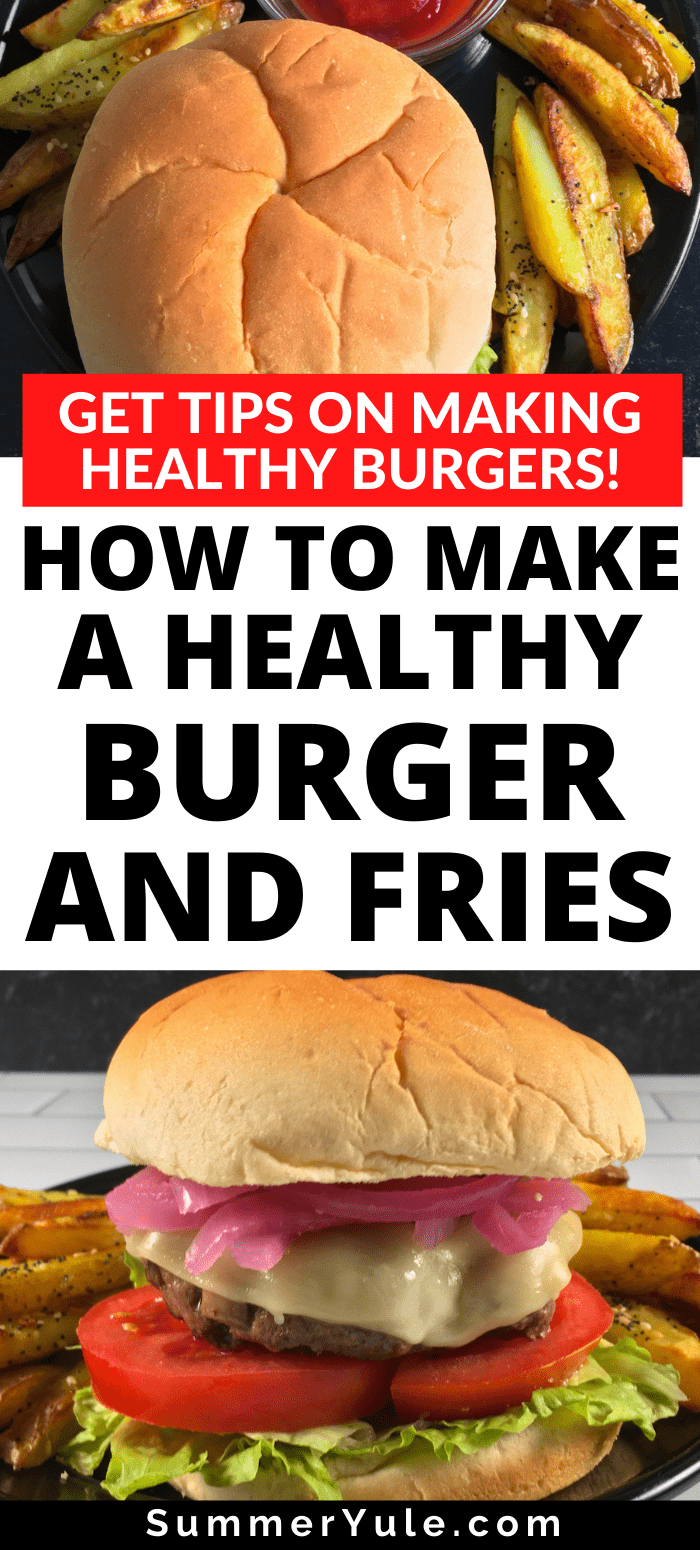
Falcon says
This was pretty good, but would’ve been even better with a bun
Summer Yule says
Yes, you may have noticed I made a bun suggestion for those that want it!